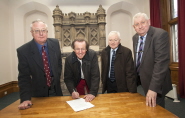A total of £1.5 million is being invested to breathe new life into the Engine Shed, which was built by Brunel and previously housed the Empire and Commonwealth Museum at the entrance to Bristol Temple Meads station.
The University’s Vice Chancellor Professor Eric Thomas and Bristol Mayor George Ferguson signed an agreement today [11 March] at a symbolic ceremony to signify the start of a new chapter for the Grade I listed building, which is set to become a focal point for Bristol’s drive to generate inward investment and encourage a new generation of high growth businesses.
The building will be managed by Bristol SETsquared – the University’s double award-winning business incubator - who will take the majority of the space to provide premium serviced offices for its early-stage technology businesses.
Around 20 companies will move in here with a further 40 businesses using the business centre’s resources and facilities including hot desks, breakout spaces and meeting rooms. In total, there will be space for 120 people.
It will also provide the headquarters for the newly launched Invest in Bristol and Bath, accommodating representatives from the four West of England Unitary Authority areas, and act as a ‘shopfront’ for potential investors in the region. It will also become the local base for UK Trade & Investment.
Core to the Engine Shed will be a business lounge and co-working and collaboration spaces for academics, entrepreneurs, innovators, investors and business leaders.
Professor Eric Thomas, Vice-Chancellor of the University of Bristol said: "Bristol is repeatedly recognised as having significantly high potential for economic growth and the intellectual capital provided by world-renowned research and the activities of some of the country's highest performing students go a long way to supporting this. I am very pleased that the University, as part of the SETsquared partnership, will be among the first present at the Enterprise Zone."
Nick Sturge, Director of the Bristol SETsquared Centre which is currently based at University Gate East in Clifton, hopes the move to the Engine Shed will allow it to support even more businesses and in turn create a predicted 750 jobs over the next five years.
He said: “It’s great to be heading up the Engine Shed facility and bringing together so many groups, from companies and entrepreneurs to academics and students. Everyone involved has a huge sense of excitement for what can be achieved in this great building. The additional space will literally allow Bristol SETsquared to grow and we hope it will become an active hub of world-class innovation and enterprise activity – located within what is arguably one of the UK’s most connected transport hubs.”
A planning application has been submitted for the Engine Shed, which is likely to be dealt with in the next few months. It was built in 1841 as the original shed for the turning of engines when they came through the Passenger Shed on the London to Bristol line.
Colin Skellett, Chairman of the West of England LEP, said: “After months of planning, it is exciting to see the birth of the Engine Shed project. City marketing must be joined up. By bringing together all our investment specialists we are creating a formidable resource to attract new jobs.
“Entrepreneurial, high growth businesses are the lifeblood of our economic growth. What better place to inspire them than Brunel’s Engine Shed. Set on the direct line to London and onto Europe, this will be an exciting focus for innovation.”
The Engine Shed will form part of the new Bristol and Bath and Bristol Temple Quarter Enterprise Zone, which will span 173 acres of land around Bristol Temple Meads train station and includes plans for a long-awaited indoor arena, new public spaces and a vibrant business, commercial and shopping district. Temple Meads station will also be completely refurbished.
It’s anticipated that the new Enterprise Zone will create 17,000 new jobs and bring 400 new companies to the city over the next two decades.
George Ferguson said: “What better springboard for our plans for the Enterprise Zone than the launch of this important project. It is very good to see this serious, solid progress on the ground. Now we need to get out and tell Europe and the rest of the world that Bristol’s open for business.”
Other key partners in the Engine Shed project are Network Rail and the Homes and Communities Agency (HCA), both of whom are key delivery partners for Temple Quarter Enterprise Zone.
With funding from the HCA, the city council bought the freehold for Brunel’s Old Station in March 2012, from the Empire and Commonwealth Museum.
Network Rail is currently working on the masterplan for the redevelopment of Temple Meads station, which includes bringing back into use part of the Old Station and Engine Shed. They have modified their plans to enable the Engine Shed development to go ahead.
Patrick Hallgate, Network Rail Western Route Managing Director, said: “We’re delighted that Brunel’s iconic Old Station is being transformed for 21st century use. As well as meeting our needs for a redeveloped station, it’s great that the Engine Shed is going to be turned into a high-tech business hub and home for the new Invest in Bristol and Bath service.”

